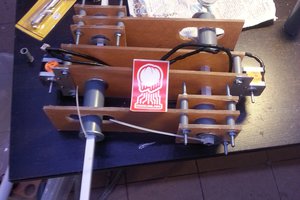A robot with two components (left and right hand) which can reach basic ukulele chords and strum/pluck strings. It will ultimately be able to play reading off of a simple MIDI file.
Left hand:
- 16 spring loaded pushers that are pushed by rods controlled by a rack and pinion, in turn controlled by a motor (1 motor per string)
- First four frets only, as it covers 36 basic chords
Right hand:
- 1 motor per string
- Allows for both strumming and plucking potential
Overarching objectives:
- Switch between chords quickly (<1 or 2 seconds per switch)
- Strumming/plucking steady and at least 150 bpm
- Can input simple MIDI files
- Minimize interfering mechanical noises


 Alain Sanguinetti
Alain Sanguinetti


 Oscar S.
Oscar S.
this is not going to work